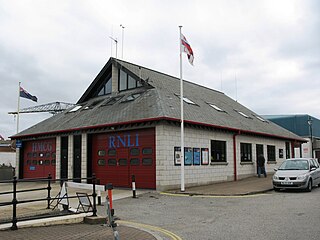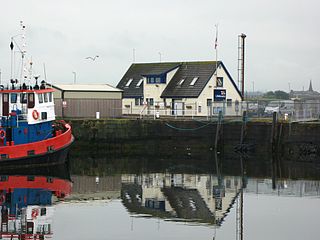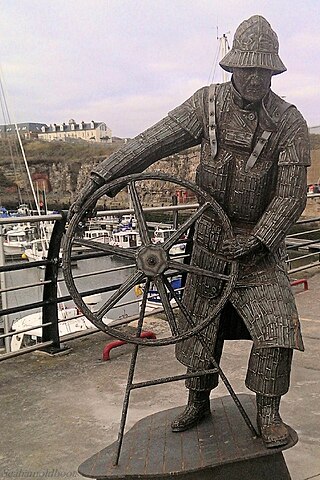
Girvan is a burgh and harbour town in Carrick, South Ayrshire, Scotland. Girvan is situated on the east coast of the Firth of Clyde, with a population of about 6,450. It lies 21 miles (34 km) south of Ayr, and 29 miles (47 km) north of Stranraer, the main ferry port from Scotland to Northern Ireland.

Padstow Lifeboat Station has been at Trevose Head west of Padstow, Cornwall, since 1967. Before that it was at Hawker's Cove on the Camel estuary between the town and the sea. The lifeboat station is run by the Royal National Lifeboat Institution (RNLI), and since 2006 has been the base for Tamar-class RNLB Spirit of Padstow.

Walmer Lifeboat Station is located on The Strand on Walmer promenade, in the county of Kent.

Cromer Lifeboat Station is an RNLI station located in the town of Cromer in the English county of Norfolk. The station operates two lifeboats – one for inshore work and the other for offshore work.

Wells-next-the-Sea Lifeboat Station is a lifeboat station in the town of Wells-next-the-Sea in the English county of Norfolk.

Falmouth Lifeboat Station is the base for Royal National Lifeboat Institution (RNLI) search and rescue operations at Falmouth, Cornwall in the United Kingdom. The first lifeboat was stationed in the town in 1867 and the present station was opened in 1993. It operates a Severn Class all-weather Lifeboat (ALB) and an Atlantic 85 inshore lifeboat (ILB).

Appledore Lifeboat Station is the base for Royal National Lifeboat Institution (RNLI) search and rescue operations at Appledore, Devon, England. The first lifeboat was stationed in the town in 1825 and the present station was opened in 2001. It operates a Tamar-class all-weather boat (ALB) and an Atlantic 85 B Class inshore lifeboat (ILB).

Poole Lifeboat Station is the base for Royal National Lifeboat Institution (RNLI) search and rescue operations at Poole, Dorset in England. The first lifeboat was stationed at Poole Harbour in 1865 and the present station was opened in 1988.

Hunstanton Lifeboat Station is a Royal National Lifeboat Institution operated lifeboat station located in the village of Old Hunstanton in the English county of Norfolk. This is the only lifeboat station on the east coast of England which faces westward, being positioned on the east side of the square-mouthed bay and estuary known as The Wash.

Skegness Lifeboat Station is a lifeboat station located in the town of Skegness, Lincolnshire, England, operated by the Royal National Lifeboat Institution (RNLI). The station is located on the seafront of the south-east coast, north of the Wash and south of the Humber Estuary. This area of the British coastline is characterised by many shoals and constantly changing sandbanks, many of which lie between the town and the East Dudgeon Lightship. The building dates from 1990 and was the first in the British Isles constructed especially for a Mersey-class lifeboat. The boathouse also accommodates an Inshore Lifeboat and a souvenir shop.

Selsey Lifeboat Station is a Royal National Lifeboat Institution (RNLI) station located in Selsey, West Sussex on the south coast of England.

Aberdeen Lifeboat Station is located at the entrance to Victoria Dock, in the harbour city of Aberdeen, in the historic county of Aberdeenshire.

New Quay Lifeboat Station is located off Glanmor Terrace, in the seaside town of New Quay, Ceredigion, West Wales.

Aberdovey Lifeboat Station is an RNLI lifeboat station in the coastal village of Aberdyfi, Gwynedd, West Wales, on the Dyfi estuary in Cardigan Bay. It was established in 1853, but there has been a lifeboat serving the village since 1837.

Plymouth Lifeboat Station is the base for Royal National Lifeboat Institution (RNLI) search and rescue operations at Plymouth in England. The first lifeboat was stationed in the city in the early 1800s. The station moved to its present site at Millbay Docks in 1992, a Grade II-listed three-storey tower. Since 2003 it has operated a Severn-class all-weather boat (ALB) along with an B-class Atlantic inshore lifeboat (ILB).

Civil Service lifeboats are a group of lifeboats belonging to the Royal National Lifeboat Institution which have been funded by The Lifeboat Fund. They usually have the Civil Service designation and number included in the name, such as RNLB E-001 Public Servant , which was on service at Tower lifeboat station on the Thames between 2002 and 2012.

Bamburgh Castle Lifeboat Station is a former Royal National Lifeboat Institution (RNLI) station, which was located at the village of Bamburgh in the county of Northumberland. A lifeboat was first stationed here by the RNLI in 1882.

Troon Lifeboat Station is the base for Royal National Lifeboat Institution (RNLI) lifeboats at Troon in South Ayrshire, Scotland. It opened in 1871 and operates both all-weather and inshore lifeboats.

Seaham Lifeboat Station is a former Royal National Lifeboat Institution (RNLI) station, which was located at the harbour town of Seaham, in County Durham.

Portpatrick Lifeboat Station is the base for Royal National Lifeboat Institution (RNLI) lifeboats at Portpatrick in Dumfries and Galloway, Scotland. It opened in 1877 and today operates an all-weather lifeboat.


























